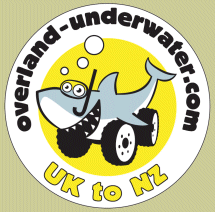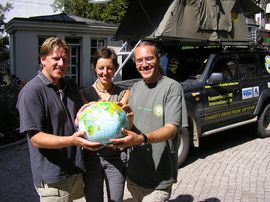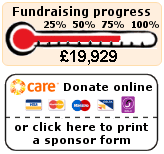| Final Statistics: Alex & Maz | Total distance: 93,550km |
| Furthest Point: Rotorua, NZ | Now settled in Sydney, Australia |
| Final Statistics: Martin | Total distance: 79,698km |
| Furthest Point: Hobart, Australia | Now settled in Bristol, UK |
Iran, the land of snow and ice but no teaspoons
Iran, Country 13, Diary entry 7th-12th Nov 2005, Total distance in Iran: 4696km
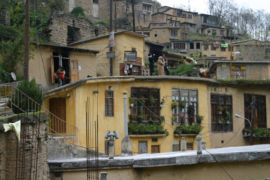 The next place we were aiming for was a small village called Masouleh which is a village built on the side of a mountain so steep that the path in front of one house is actually the roof of the house below. It's been listed by UNESCO so we thought that was a good enough endorsement for us to take a look. The road from our camping spot took us past the edge of Rasht, the biggest town in the region and home of the best biscuits of the trip so far with the consistency of pastry and formed into a spiral with cinnamon flavoured sugar trapped in the grooves - very nice indeed but better they lived in Alex and Maz's car so I wouldn't wolf the lot. We stopped at another small town along the way for fuel and food to cook for the evening (we decided to pass on the sheep's heads on sale at the sheep's head shop) and arrived at the village.
The next place we were aiming for was a small village called Masouleh which is a village built on the side of a mountain so steep that the path in front of one house is actually the roof of the house below. It's been listed by UNESCO so we thought that was a good enough endorsement for us to take a look. The road from our camping spot took us past the edge of Rasht, the biggest town in the region and home of the best biscuits of the trip so far with the consistency of pastry and formed into a spiral with cinnamon flavoured sugar trapped in the grooves - very nice indeed but better they lived in Alex and Maz's car so I wouldn't wolf the lot. We stopped at another small town along the way for fuel and food to cook for the evening (we decided to pass on the sheep's heads on sale at the sheep's head shop) and arrived at the village.
On initial look it wasn't as impressive as we'd hoped. Everything is painted a pale yellow, which would be nice if it were clean but it's the kind of dirty nicotine yellow you get on pub ceilings. We weren't about to be put off by that though, and on walking in to the centre of the village it turned out to be as picturesque as hoped, with local craftsmen getting on with their lives as if tourists weren't watching - a blacksmith hammering some agricultural implement into shape, a baker making some bread (decent flat bread, not that nasty wallpaper stuff) etc. and since the buildings were made largely of mud (the roofs at least) they required constant maintenance, and there was a squadron of wheelbarrow men constantly streaming up and down the hillsides with their loads of mud. You had to be careful where you walked because the paths widened and narrowed with the shapes of the houses below so it would have been easy to fall off someone's roof and onto the someone else's roof below, and since it was all made of mud it wouldn't surprise me if you could go straight through.
We took our time and sat down for a cup of tea or two (the village was obviously stuck in the time before teaspoons were invented) and returned to the cars which we'd parked next to the police station, and in keeping with our daily encounters with the police they wouldn't let us go unchallenged! We had to dig our passports out of the cars for inspection but no problem because of course everything was in order and the police kindly offered us a cup of tea, which we had to decline as we wanted to find camp before dark. We found a small dirt trail off the side of the road which led down to the raging stream which formed the valley through which the road ran, and found two spots where we could make the tents level before making another tasty chicken stew with our new-found pressure cooker expertise - 15 minutes cooking and the chicken was falling off the bone - I'll be pressure cooking even after I'm living in a house again!
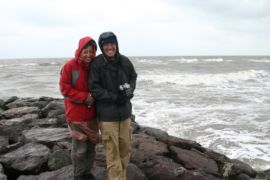 Alex particularly wanted to see the Caspian Sea. I wasn't too bothered because I'd heard that Iran exports nearly all of the caviar it produces so for me there was no point, but it wasn't far out of our way so I was happy to go for an ice cream at the seaside. We headed north to the edge of the sea, which is supposedly very popular with Iranian tourists in peak season, but all we could find were docks, docks and more docks. Added to that the weather was grey and miserable, but we did get out of the cars to walk along a breakwater, being careful not to get blown away by the high winds. It was quite exhilarating but we decided not to hang around more than a few minutes - it was starting to rain horizontally and none of us was keen to get soaked to the bone again like we had on the volcano a couple of days previously.
Alex particularly wanted to see the Caspian Sea. I wasn't too bothered because I'd heard that Iran exports nearly all of the caviar it produces so for me there was no point, but it wasn't far out of our way so I was happy to go for an ice cream at the seaside. We headed north to the edge of the sea, which is supposedly very popular with Iranian tourists in peak season, but all we could find were docks, docks and more docks. Added to that the weather was grey and miserable, but we did get out of the cars to walk along a breakwater, being careful not to get blown away by the high winds. It was quite exhilarating but we decided not to hang around more than a few minutes - it was starting to rain horizontally and none of us was keen to get soaked to the bone again like we had on the volcano a couple of days previously.
As we passed again through Rasht on the way south we sought out the bakery where we'd bought the cinnamon sugar biscuits and stocked up with another couple of packets - you never know when you might need more biscuits after all, and they proved to be good for breakfast supplies as our malaria pills (Doxycycline) make you feel really sick if you take them on an empty stomach. Easier to eat something and take the pill first thing in the morning than risk forgetting them later in the day. As we pulled out of Rasht our Land Cruisers were attracting the usual attention and one person even passed us taking photos out of their car windows, which they subsequently emailed to us! More exciting for us was one roundabout where a bus had failed to turn and gone straight into the middle of the roundabout, which unfortunately was a couple of metres lower than road level, so it was precariously balanced with front end on the grass and back end on the road with its middle in fresh air. This was not the first accident we'd seen in Iran nor would it be the last - the roads in Iran are very good and the average motorist can achieve a much higher speed than would be possible in most of the previous countries we'd visited in the region, but the average motorists' skills are still no more than average so there are a lot of accidents and often pretty serious. The driving conditions turned bad again as we headed south and we saw a couple of other crashed cars at the side of the road and one lorry that had managed to crash through the Armco barrier and hang off the edge of a cliff.
With the ever-worsening conditions turning to torrential rain again we decided to find a hotel for the night again, this time stopping in Qazvin. The Lonely Planet had a few recommendations for things to see and do in Qazvin but our priorities were food (naturally) and internet. The first proved pretty simple - we had a kebab. Actually there wasn't very much open so though we were getting pretty sick of kebabs, that was all there was. We then tried to follow the map in the Lonely P to the internet place and where we thought it should be was only a closed computer shop.
We popped into the bread shop to ask if they knew where we could find the internet caf� ("coffee net" in Farsi!), when a customer offered to take us. OK... then he motioned towards his car! Hmmm, it was supposed to be nearby, and we weren't sure with his broken English and our non-existent Farsi whether he'd understood where we wanted to go, but we decided that with three of us we should be OK in case anything happened so got in. He took us the opposite direction to what we expected and we were debating how far we should go before asking to be let out, when we pulled up outside a mosque which was very ornately decorated, and there was a room to one side where a service was going on. We weren't allowed in, but we could look through the window and a kind assistant brought us out a cup of tea each, again without teaspoons to stir in the sugar, so we had a nice syrupy final mouthful before we went back to the car and on to the coffee net... or so we thought!
Next stop was a mausoleum, which had a nice entrance way opening to a large courtyard with the most spectacular inner sanctum. The rain was falling, the building was floodlit and totally covered in small mirror tiles so the whole thing shone so magnificently, it was a most amazing sight. Unfortunately since we weren't expecting to be sight-seeing I didn't have my camera! Luckily Alex had his so stand by for the Iran photo album soon! We had a look inside where it was also encrusted with mirrors with the big tomb in the centre, and then walked around the outside again to the back entrance, outside which was a memorial to the locals who had fallen in the Iran-Iraq war. All over Iran in the villages there are big signs with portraits of the local boys who died but this was on such a larger scale, and each individual memorial was very moving as it contained a small display cabinet for each soldier where relatives had put a photo of their loved one together with some personal items like watches or favourite books or poems. Each row contained 20 cabinets and there were several hundred rows! We were told that around 20,000 people from Qazvin were killed during the eight years of that war.
Getting back into the car we again asked for coffee net but next stop was a brick cistern used since ancient times for storing water for the city, before finally we were taken to the coffee net - our impromptu guide had understood what we were after all along but just wanted to show off his city! He waited for us while we spent half an hour on the internet (and we could show him the Farsi version of our flyer so he could actually know what we were doing in his country!) and then he drove us back to our hotel.
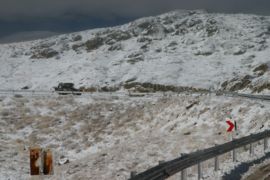 The next day we set off towards Alamut, famous for the Castles of the Assassins, and as we approached the mountains they looked very pretty covered in snow - we'd have another cold night but we decided it was worth it. What wasn't so worth it though was the snow sticking to the roads making the driving conditions lethal! I was starting to think about telling Alex and Maz to go ahead if they wanted but I didn't want to risk it, when just then they got on the radio to say they wanted to call it a day too! They were in the lead and they saw one car descending the hill totally fail to turn a bend - the front wheels were turned but skidding forwards and the chap must have had a real brown trouser moment as his car, containing what looked like his entire family, stopped a matter of only 6 inches from the edge of a sheer drop of a couple of hundred metres! Following behind I only saw the guy parked there but he certainly looked quite pale. There were safety barriers along the straight sections of the road but were missing from the bends, which to me seemed a little strange but maybe they just had so many accidents there they decided it was too expensive to keep replacing the barriers all the time?
The next day we set off towards Alamut, famous for the Castles of the Assassins, and as we approached the mountains they looked very pretty covered in snow - we'd have another cold night but we decided it was worth it. What wasn't so worth it though was the snow sticking to the roads making the driving conditions lethal! I was starting to think about telling Alex and Maz to go ahead if they wanted but I didn't want to risk it, when just then they got on the radio to say they wanted to call it a day too! They were in the lead and they saw one car descending the hill totally fail to turn a bend - the front wheels were turned but skidding forwards and the chap must have had a real brown trouser moment as his car, containing what looked like his entire family, stopped a matter of only 6 inches from the edge of a sheer drop of a couple of hundred metres! Following behind I only saw the guy parked there but he certainly looked quite pale. There were safety barriers along the straight sections of the road but were missing from the bends, which to me seemed a little strange but maybe they just had so many accidents there they decided it was too expensive to keep replacing the barriers all the time?
Coming down the mountain we stopped for a quick cuppa in a howling gale, which seemed like a good idea at the time but looking back I don't remember why we thought that, and after a quick oil change at a local garage we decided to just press on southwards, leaving the Castles of the Assassins for next time.
The day then consisted of a long drive. We had agreed that we would not visit Tehran, mostly because there's not so much to see there as other towns, and also there were anti-British protests going on outside the embassy at the time, but the road almost took us there but skirted round the centre itself on the city's ring road and some interesting traffic conditions before finding the exit heading south. After another good few hours driving with only a single stop at an Iranian motorway service station fast food restaurant (it was as good as it sounds!) we camped in the desert just before Kashan, our stop for the next day.
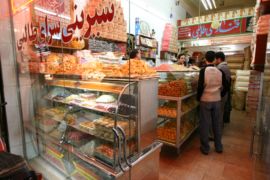 Kashan turned out to be a very beautiful city with much more to see than the brief entry in the Lonely P would suggest. First stop was the bazaar where we arrived just in time for closing but we managed a half-hour look around. We were shown around by three local boys who were very proud to have some westerners in their town, and when we said we'd heard the roof of the market was worth a look, they led us through one of the traders' back rooms, up a little rickety ladder and through a tiny window onto the roof.
Kashan turned out to be a very beautiful city with much more to see than the brief entry in the Lonely P would suggest. First stop was the bazaar where we arrived just in time for closing but we managed a half-hour look around. We were shown around by three local boys who were very proud to have some westerners in their town, and when we said we'd heard the roof of the market was worth a look, they led us through one of the traders' back rooms, up a little rickety ladder and through a tiny window onto the roof. 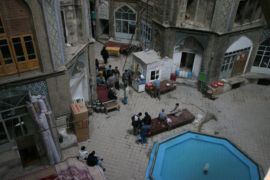 From there you can see the main dome of the market which has a large opening in the centre, and we could climb up and peer down on people going about their business below. As we were further south this area experiences hotter summers and we saw the first examples of the ancient method used for cooling their houses - the buildings have "badgirs" which look like chimneys but are designed to funnel the breezes downwards and into the living areas.
From there you can see the main dome of the market which has a large opening in the centre, and we could climb up and peer down on people going about their business below. As we were further south this area experiences hotter summers and we saw the first examples of the ancient method used for cooling their houses - the buildings have "badgirs" which look like chimneys but are designed to funnel the breezes downwards and into the living areas. 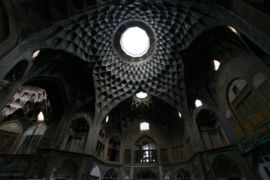 Like chimneys on posh houses in the UK, many people have taken the opportunity to be lavish with ornate styling of their wind towers and creative inside the building, channelling the breezes over water pools to cool the air even further. A very enviro-friendly A/C system!
Like chimneys on posh houses in the UK, many people have taken the opportunity to be lavish with ornate styling of their wind towers and creative inside the building, channelling the breezes over water pools to cool the air even further. A very enviro-friendly A/C system!
We decided to get some food and in the circular courtyard under the main dome of the market we'd seen from above that there was a little snack place there, so we made a bee-line for it and discovered that they were selling dizi, the stew we'd tried in Tabriz. The man selling the dizi pulled out three red hot metal jars from the furnace (using his bare hands!) and got really enthusiastic with his plunging action once the video camera came out to film him mashing the stuff from its recognisable food form into baby food mush. It tasted great though.
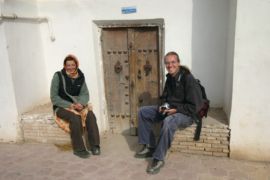 Strength restored, we walked across the town past the traditional houses towards the next mosque, noting on the way another feature we'd not seen before - His and Hers door knockers! Each door had two knockers, one like a ring and one just a heavy bar. The theory is that men and women have separate door knockers so the people inside know the sex of the person calling, so the right sex person can go and answer the door! It just wouldn't do for a lady to answer the door to a gentleman, what would the neighbours think?
Strength restored, we walked across the town past the traditional houses towards the next mosque, noting on the way another feature we'd not seen before - His and Hers door knockers! Each door had two knockers, one like a ring and one just a heavy bar. The theory is that men and women have separate door knockers so the people inside know the sex of the person calling, so the right sex person can go and answer the door! It just wouldn't do for a lady to answer the door to a gentleman, what would the neighbours think?
We got to the Agha Bozorg mosque and found it overrun with art students sketching and painting, so we decided not to stand still for too long for fear of being immortalised, but in our brief visit we were once again very impressed with the extreme detail of the decoration. The mihrab (the niche that indicates the direction of Mecca) was intricately decorated with colourful tiles, the sunken courtyard for which this mosque is famous was very pretty (though with works going on) and the main door was encrusted with a huge number of rivets, supposedly the exact same number as there are verses in the Koran. I'll count the steps to check a sign is correct but I decided not to confirm this one.
Kashan is also famous for the houses built and inhabited by wealthy merchants of the mid 1800s - real luxury houses in the middle of town. As we were walking up to the first we were approached by an Iranian chap in his early 20s who said "do you mind if I have a friendly chat?" It was obvious that he only wanted to practice his English and wasn't about to try to sell anything so we were happy to explain who we were and what we were doing in his town. His name was Hossein and he decided he would be our guide for the afternoon, took us into the Abbasian House and even paid for us to get in! It was interesting to have a guide to tell us what all the strange rooms were used for, and he explained to us the most unusual feature of the house. Fresh water was drawn up from a well using a strange paddle wheel system none of us could figure out, from where it was allowed to run through channels through many of the rooms and pools with fountains in the courtyards to make the place cooler. It also passed underneath the bottom of the very ornate octagonal badgirs to cool the breeze, and through the kitchen to provide moving pools over which meat was hung - a nice system to keep the place clean.
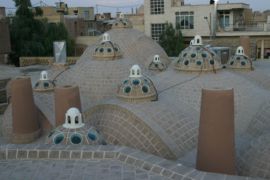 The house had been very well restored but with some way to go... many of the main rooms were complete but others were closed for renovation, and others still had families living in them so are unlikely to become part of the museum.
The house had been very well restored but with some way to go... many of the main rooms were complete but others were closed for renovation, and others still had families living in them so are unlikely to become part of the museum.
Following the house we visited a nearby hammam, an old bath house now converted into a museum and tea house. We bought Hossein a cup of tea and once again they served them with sugar lumps but without teaspoons. Finally we found out the reason there are no teaspoons! In Iran one takes a sugar lump in one's mouth and sips the tea through the sugar! Interesting idea so we had to try it, but it didn't work very well for me, I got a lot of sugar between sips and not so much actually sweetening the tea. What's more I got through three or four times as much sugar. We looked around the hammam but having seen several already on our trip it was merely nice rather than mind blowing, but then we went on the roof there and saw the strange moonscape of domes of each room dotted with circular windows in each to allow the light in. Very odd.
After a quick half hour on the internet we took our guide out to the Fin Gardens on the edge of town and bought Hossein dinner (guess what we ate?) to say thanks for his time, and then we headed out of town and drove for a couple of hours before camping off the side of the road just before a small town called Abyaneh. Middle of nowhere but still dogs barking all around us!
Abyaneh is one of the oldest villages in Iran and was originally Zoroastrian, but under the intolerant Shah Ismail I most of these fled to Yazd or to India. Due to its remoteness it has kept its traditional costumes and way of life, for example unlike the rest of the country the women there have quite a colourful traditional dress. It was a pleasant place to walk around and look at the traditional houses and crafts, but although western tourists are still a novelty there were quite a few Iranian tourists (especially as it was a Friday so the weekend) there so the ladies of the village were quite used to springing out of their houses to push their tourist tat onto us. Once again it started to snow, so we decided to get on the road again and back to a slightly lower altitude before conditions got any worse.
 We managed to get to Esfahan late that afternoon and headed straight for the river. Esfahan is a beautiful city and is known for amongst other things the bridges across the river, which are very ornate and some containing tea houses underneath their arches. We parked next to the Khaju Bridge and spent some time there ambling across, taking photos and generally people watching. There were many people out as it was quite a nice afternoon by that time and there's not much else to do on a Friday afternoon than be out seeing and being seen.
We managed to get to Esfahan late that afternoon and headed straight for the river. Esfahan is a beautiful city and is known for amongst other things the bridges across the river, which are very ornate and some containing tea houses underneath their arches. We parked next to the Khaju Bridge and spent some time there ambling across, taking photos and generally people watching. There were many people out as it was quite a nice afternoon by that time and there's not much else to do on a Friday afternoon than be out seeing and being seen. 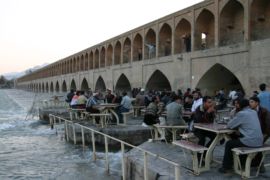 We walked along the bank of the river to another bridge called the Si-o-Seh bridge, the name meaning "thirty three" in Farsi and signifying the bridge's 33 arches. We stopped at a tea house under one of the first few arches and had another cup of tea there - again with no teaspoons but this time we were no longer na�ve tourists and we each grabbed a rock-hard lump of sugar to sip our tea through like professionals.
We walked along the bank of the river to another bridge called the Si-o-Seh bridge, the name meaning "thirty three" in Farsi and signifying the bridge's 33 arches. We stopped at a tea house under one of the first few arches and had another cup of tea there - again with no teaspoons but this time we were no longer na�ve tourists and we each grabbed a rock-hard lump of sugar to sip our tea through like professionals.
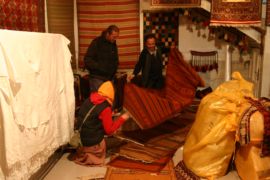 We explored a little way into the town and found the Chahar Bagh gardens for a quick stroll before arriving at the Imam Square.
We explored a little way into the town and found the Chahar Bagh gardens for a quick stroll before arriving at the Imam Square.
Imam Square is the centrepiece of Esfahan. Created in 1602, it is around 500 meters long and 165 meters wide which is not exactly square but makes it the second largest town square in the world after Tiananmen Square in Beijing, and the largest to be completely surrounded by buildings. Esfahan used to be the capital of Persia and traditionally the ancient rulers of Iran used to watch polo matches played here. Nowadays the centre is mostly a large grassy garden with some fountains and pools, and around the edges are shops and bazaars, mid way along one side is the Ali-Qapu Palace with its polo viewing platform, opposite it the Sheikh-Lotfollah Mosque and at the southern end the immense Imam Mosque.
We only had a very quick look because the real number one on the agenda was the Nomad's carpet shop on the edge of the square. The shop owner has a very much more laid-back approach to selling than most of the carpet traders around the square and we appreciated his patience as we unfolded nearly every carpet in the shop... but the one that caught Maz's eye was actually hanging on the wall at the back of the shop. We got that one down too to compare it against all the others. Soon there was a large pile of discarded carpets which the ever-patient shop helpers would have to fold up again later. Although I wasn't in the market I found it fascinating to learn about all the different styles, both in the pattern and in the weave, depending on the region.
Having narrowed down the choices to half a dozen or so, we decided we'd all had carpet overload and the shopkeeper put our choices to one side to await us the next day. We were told to come back at 1:00pm because then we'd be just in time for lunch!
 We headed out of town towards a hotel where we'd been told we could camp, and returned in the morning for a more thorough exploration of Esfahan.
We headed out of town towards a hotel where we'd been told we could camp, and returned in the morning for a more thorough exploration of Esfahan.
We decided to split up for the day and my first port of call (after breakfast - just so I could take my malaria pill of course) was the Chehel Sotun Palace built for Shah Abbas II in 1647. The name is Farsi for "forty columns" - the roof of the front of the palace is supported by twenty columns which are reflected in a pool of water in the garden making forty total, though it didn't really work well when I looked. The gardens and the outside of the palace were quite nice but the inside was the real attraction, with the walls of the main room painted to show the shah's victories over his enemies and other important battles. 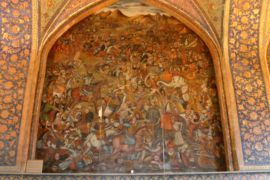 My favourite was the Karnal battle scene and I think people going to war should take elephants more often.
My favourite was the Karnal battle scene and I think people going to war should take elephants more often.
Next I had a look around the bazaar, getting hopelessly lost in the non-touristy areas, and finally I managed to find my way back to Imam Square in time for lunch at Nomad's. We had the standard chicken and rice but it tasted all the more special for the fact that we were all spread out on the nice soft carpets - we were all very careful not to spill anything on the merchandise! This was followed by more tea (by now I had given up on the sugar) and more of the caramel stuff they kept giving us. This was really nice - it was like a toffee apple but without the apple, and very more-ish, but got stuck in your teeth and you had to spend the next ten minutes trying to work it all out with your tongue. Definitely a "money's worth" food. A carpet was chosen, but we decided to go back later and finalise the deal to take advantage of the remaining daylight (sunset being at around 4:30pm).
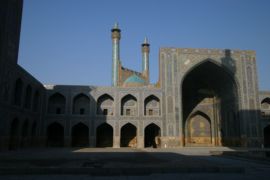 I went to the two mosques. First was the Imam Mosque which is one of the most striking images of Iran. Built in 1611 (when it was known as the Shah Mosque until the revolution in 1979) the dome and minarets are huge and covered with brilliant turquoise tiles they just look exquisite, though unfortunately the dome was covered in scaffolding. Inside the mosque is also very ornately decorated. Strangely, the area around the mihrab is not used for prayers except on a Friday. There's a cordoned off area towards the back of the mosque where people were praying, and apart from that area one could walk around inside the rest of the mosque without removing one's shoes, which was very important when I got to the point under the centre of the dome... There is a black flagstone where if you stamp on it, the noise is reflected back from the dome as an echo and keeps reverberating. I counted seven echoes but I was wearing soft soled shoes. Maybe I should go back in tap shoes because apparently it's possible to hear 12 echoes with the ear but scientists have used sensitive microphones and measured more than a hundred! I wonder what important studies those scientists are now involved in.
I went to the two mosques. First was the Imam Mosque which is one of the most striking images of Iran. Built in 1611 (when it was known as the Shah Mosque until the revolution in 1979) the dome and minarets are huge and covered with brilliant turquoise tiles they just look exquisite, though unfortunately the dome was covered in scaffolding. Inside the mosque is also very ornately decorated. Strangely, the area around the mihrab is not used for prayers except on a Friday. There's a cordoned off area towards the back of the mosque where people were praying, and apart from that area one could walk around inside the rest of the mosque without removing one's shoes, which was very important when I got to the point under the centre of the dome... There is a black flagstone where if you stamp on it, the noise is reflected back from the dome as an echo and keeps reverberating. I counted seven echoes but I was wearing soft soled shoes. Maybe I should go back in tap shoes because apparently it's possible to hear 12 echoes with the ear but scientists have used sensitive microphones and measured more than a hundred! I wonder what important studies those scientists are now involved in.
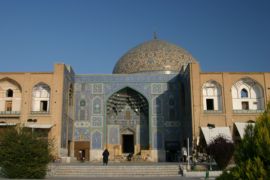 Then I went to the Sheikh-Lotfollah Mosque. This mosque was originally for the ladies of the shah's court, and there is apparently a passageway underneath the square from the palace directly opposite so that the ladies could go to pray without being seen by any lecherous men. It is unusual in that there are no minarets, but since the towers from the Imam mosque at the end of the square are so huge they could probably do without. Yet another mosque ticked off the list, but again it was so ornately decorated, this one especially so on the inside of the dome.
Then I went to the Sheikh-Lotfollah Mosque. This mosque was originally for the ladies of the shah's court, and there is apparently a passageway underneath the square from the palace directly opposite so that the ladies could go to pray without being seen by any lecherous men. It is unusual in that there are no minarets, but since the towers from the Imam mosque at the end of the square are so huge they could probably do without. Yet another mosque ticked off the list, but again it was so ornately decorated, this one especially so on the inside of the dome.
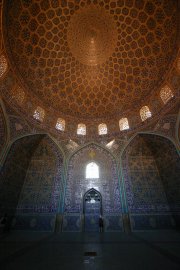 Time was ticking on, so after that mosque followed by a brief chat and photo shoot with a load of giggling Iranian girls who were fascinated by my blonde hair, it was time to return once again to Nomad's to finalise the deal.
Time was ticking on, so after that mosque followed by a brief chat and photo shoot with a load of giggling Iranian girls who were fascinated by my blonde hair, it was time to return once again to Nomad's to finalise the deal.
After much deliberation we all agreed that the carpet Maz had spied hanging on the back wall was the nicest so that was packaged up for posting home to Harpenden HQ (Andy and Pips), and Alex and I decided we really liked the carpet bedding bags they had on display in the window. They are huge bags about 60 years old, made out of handmade carpet with big leather straps and buckles and were used for carrying bedding on the backs of camels or donkeys. Despite their obvious use and exposure to the sun, they are still brightly coloured as the dyes used are all vegetable based and not chemical. Mine is now taking up valuable space in the back of my car and accompanying me around the world!
Shopping successfully completed (half an hour after normal closing time) we were all happy, satisfied with our purchases and content with seeing the best of Esfahan.
| All content copyright � overland-underwater.com - please do not use without permission. |
| Comment from Scooter & H |
| you must all be putting on weight nicely with all of that sugar & tea ;0) fun carpet bagging isn't it ! |
| 19 Jan 2006 @ 22:32:26 |
